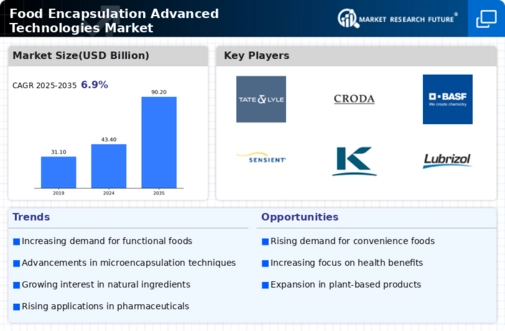Market Growth Projections
The Global Food Encapsulation Advanced Technologies Market Industry is projected to experience substantial growth over the next decade. With an estimated market value of 43.4 USD Billion in 2024, it is expected to reach 90.2 USD Billion by 2035, reflecting a compound annual growth rate (CAGR) of 6.88% from 2025 to 2035. This growth is indicative of the increasing adoption of encapsulation technologies across various food sectors, driven by factors such as health trends, technological advancements, and consumer preferences for natural and convenient food products.
Regulatory Support for Food Safety
Regulatory support for food safety is a critical driver for the Global Food Encapsulation Advanced Technologies Market Industry. Governments worldwide are increasingly emphasizing food safety standards, which necessitate the use of advanced technologies to ensure product integrity and consumer protection. Encapsulation technologies help in maintaining the quality and safety of food products by preventing contamination and extending shelf life. As regulations become more stringent, manufacturers are likely to invest in encapsulation solutions to comply with these standards. This regulatory landscape is expected to propel market growth, contributing to the anticipated increase from 43.4 USD Billion in 2024 to 90.2 USD Billion by 2035.
Rising Demand for Functional Foods
The Global Food Encapsulation Advanced Technologies Market Industry experiences a notable surge in demand for functional foods, driven by consumers' increasing health consciousness. As individuals seek products that offer health benefits beyond basic nutrition, encapsulation technologies play a crucial role in delivering bioactive compounds effectively. This trend is reflected in the market's projected growth, with a valuation of 43.4 USD Billion in 2024 and an anticipated increase to 90.2 USD Billion by 2035. The compound annual growth rate (CAGR) of 6.88% from 2025 to 2035 indicates a robust expansion, highlighting the importance of encapsulation in enhancing the stability and bioavailability of nutrients.
Growing Interest in Natural Ingredients
The Global Food Encapsulation Advanced Technologies Market Industry is witnessing a growing interest in natural ingredients, as consumers increasingly prefer products that are free from synthetic additives. Encapsulation technologies facilitate the use of natural flavors, colors, and preservatives, which can be sensitive to environmental factors. By protecting these ingredients from degradation, encapsulation not only enhances product appeal but also aligns with consumer preferences for clean label products. This trend is expected to contribute to the market's growth, with a projected valuation of 90.2 USD Billion by 2035, reflecting a shift towards more natural and health-oriented food options.
Consumer Preference for Convenience Foods
The Global Food Encapsulation Advanced Technologies Market Industry is significantly influenced by the rising consumer preference for convenience foods. As lifestyles become busier, there is an increasing demand for ready-to-eat and easy-to-prepare food products. Encapsulation technologies play a vital role in enhancing the convenience of these products by ensuring that flavors, nutrients, and other functional ingredients are preserved until consumption. This trend is reflected in the market's growth trajectory, with projections indicating a rise from 43.4 USD Billion in 2024 to 90.2 USD Billion by 2035, driven by the need for convenient yet nutritious food options.
Technological Advancements in Encapsulation Techniques
Technological advancements significantly influence the Global Food Encapsulation Advanced Technologies Market Industry, as innovations in microencapsulation and nanoencapsulation enhance the efficiency and effectiveness of food products. Techniques such as spray drying, coacervation, and liposome encapsulation are being refined, allowing for improved control over release mechanisms and targeted delivery of flavors, nutrients, and preservatives. These advancements not only improve product quality but also extend shelf life, which is crucial for manufacturers. As a result, the market is poised for growth, with projections indicating a rise from 43.4 USD Billion in 2024 to 90.2 USD Billion by 2035, driven by the increasing adoption of these advanced technologies.





















Leave a Comment